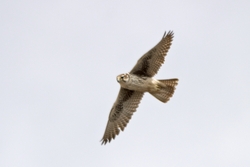
Prairie Falcon
This is the somewhat wordy trip report, and for those that are not fascinated by minutiae I've provided a summary of birds seen and where I saw them, and varations upon directions to the Lane Guide. The title from this page comes from the fact that I had some sort of chest cold throughout the trip and both live at sea level and am not spectacularly fit. It's not a great combination for birding at altitude.
The two biggest factors in this trip were the need to get up well before dawn for Grouse/Prairie-Chicken leks and the weather. The former meant that lek locations, and the need to be near one most nights, dominated the schedule. The weather on the first day was fine, but by the second day a low had set itself up south-west of Colorado pushing waves of rain into the state, followed by a front on the next weekend. This meant that for 10 of the 11 birding days I always had to work out how to avoid the worst of the weather. Ironically the single best birding day, with 3 life birds, was one of the worst days for weather (almost continual rain and/or snow), but then that same weather prevented the Sharp-tailed Grouse coming to the lek that same morning. The first week in April is notoriously troublesome for weather in Colorado, apparently.
General environmental decline and also birder pressure has undoubtedly changed the nature of easily-viewable grouse leks over the years since 2004. See, for example, the birder behavior at the remote Lesser Prairie-Chicken lek in south-eastern Colorado. I think that lek is either abandoned or closed (or perhaps both). As an offset, the amount of eco-tourism options have expanded, so it'll cost you more $$ but you'll still get to see the birds.
| Trumpeter Swan | Cattail Pond in Loveland |
| Canada Goose | All lakes/rivers |
| Wood Duck | Carrizo Cyn |
| Gadwall | Various lakes |
| American Wigeon | Various lakes |
| Mallard | All lakes/rivers |
| Blue-winged Teal | South-west and Utah lakes |
| Cinnamon Teal | South-west and Utah lakes |
| Northern Shoveler | Various lakes |
| Northern Pintail | Various lakes |
| Green-winged Teal | Various lakes |
| Redhead | Various lakes |
| Ring-necked Duck | Various lakes |
| Lesser Scaup | Various lakes |
| Bufflehead | Various lakes |
| Common Goldeneye | Various lakes |
| Barrow's Goldeneye | Lake near Granby on US-40 |
| Common Merganser | Various lakes (Hayden, Walden etc) |
| Ruddy Duck | Pelican Lake in Utah |
| Chukar | Coal Canyon at Cameo |
| Ring-necked Pheasant | Pawnee Grasslands, Ouray NWR in Utah |
| Greater Sage-Grouse | CR-3/Rt-13 north of Craig, 80 Route north of Hayden |
| Gunnison Sage-Grouse | Waunita Hot Springs lek near Gunnison |
| Sharp-tailed Grouse | 20 mile Route lek near Hayden |
| Greater Prairie-Chicken | lek north of Wray |
| Lesser Prairie-Chicken | Campo Lek in Comanche Natl Grasslands |
| Wild Turkey | Cottonwood Cyn, Ouray NWR in Utah, south-west corner |
| Gambel's Quail | Ullaweep Canyon ???? |
| Pied-billed Grebe | Cattail Pond at Loveland |
| Horned Grebe | Pelican Lake in Utah |
| American White Pelican | Cattail Pond at Loveland |
| Great Blue Heron | Various riparian |
| Turkey Vulture | Various, especially west |
| Osprey | Blue Mesa Reservoir |
| Bald Eagle | Blue Mesa Reservoir |
| Northern Harrier | Pawnee Grasslands |
| Cooper's Hawk | Sage scrub south of Gunnison |
| Red-tailed Hawk | Grasslands to montane |
| Ferruginous Hawk | Middle Park |
| Rough-legged Hawk | North Park, etc |
| Golden Eagle | North Park, San Luis Valley etc |
| American Kestrel | Ubiquitous riparian to scrub |
| Prairie Falcon | North Park near Walden |
| Sandhill Crane | Yampa River etc near Hayden |
| Killdeer | Various lowland incl Pawnee Grasslands |
| Mountain Plover | Pawnee Grasslands |
| Long-billed Curlew | Comanche Grasslands near Campo |
| Ring-billed Gull | Prince Lake #2, road to Pawnee Grasslands (Rt-14) |
| California Gull | Walden Reservoir |
| Rock Pigeon | Towns, cities |
| Mourning Dove | Grasslands and desert |
| Greater Roadrunner | Cottonwood Cyn |
| White-throated Swift | Colorado National Monument |
| Belted Kingfisher | Pine Valley Ranch Park |
| Lewis's Woodpecker | Cottonwood Cyn |
| Red-naped Sapsucker | Montane (one location only) |
| Hairy Woodpecker | Pine Valley Ranch Park |
| American Three-toed Woodpecker | Pine Valley Ranch Park |
| Northern Flicker | Montane to mid-elevation |
| Eastern Phoebe | Cottonwood and Carrizon Cyns |
| Say's Phoebe | Various cyns |
| Loggerhead Shrike | Cactus Garden at Ullaweep Cyn |
| Steller's Jay | Montane |
| Blue Jay | Wray |
| Western Scrub-Jay | Sage scrub in west |
| Pinyon Jay | Ullaweep Cyn, Coal Cyn, Colorado Natl Monument |
| Clark's Nutcracker | Montane (mostly) |
| Black-billed Magpie | Riparian, farmland |
| American Crow | Riparian, farmland |
| Chihuahuan Raven | Carrizo Cyn |
| Common Raven | Mountains to desert |
| Horned Lark | All habitats except montane |
| Tree Swallow | South-west corner Reservoirs |
| Barn Swallow | South-west corner Reservoirs |
| Black-capped Chickadee | Various montane |
| Mountain Chickadee | Various montane |
| Bushtit | South-west corner |
| Red-breasted Nuthatch | Cameron Pass Visitor Center, Pike National Forest |
| White-breasted Nuthatch | Pike National Forest |
| Rock Wren | Coal Canyon at Cameo, Pawnee National Grasslands |
| Canyon Wren | Heard only, multiple canyons and mesas |
| American Dipper | Pine Valley Ranch (also probably nr Hayden) |
| Golden-crowned Kinglet | Pine Valley Ranch |
| Blue-gray Gnatcatcher | Carrizo Cyn |
| Western Bluebird | mainly Western low- to mid-elevation |
| Mountain Bluebird | Widespread but not numerous |
| Townsend's Solitaire | Gateway in Ullaweep Cyn, Cottonwood Cyn |
| American Robin | Ubiquitous: montane to habitation in deserts |
| Sage Thrasher | near Colorado Natl Monument, Utah desert near Vernal |
| European Starling | Not that numerous but widespread |
| Spotted Towhee | Grasslands and scrub |
| Cassin's Sparrow | Campo lek in Comanche Grasslands |
| Rufous-crowned Sparrow | Cottonwood Canyon near picnic area |
| Chipping Sparrow | 80 Route near Hayden |
| Vesper Sparrow | Colorado National Monument area, 80 Route near Hayden |
| Black-throated Sparrow | Coal Canyon at Cameo |
| Fox Sparrow | Cameron Pass Visitor Center |
| Song Sparrow | Lower montaine, riparian |
| White-crowned Sparrow | Comanche Grasslands near Campo |
| Dark-eyed Junco | Montane (Gray-headed), sage-brush (Oregon) |
| McCown's Longspur | Pawnee National Grasslands |
| Chestnut-collared Longspur | Pawnee National Grasslands |
| Red-winged Blackbird | Riparian and wetter grassland areas |
| Western Meadowlark | Everywhere except montane |
| Yellow-headed Blackbird | Pelican Lake in Utah |
| Common Grackle | Plains |
| Great-tailed Grackle | west of Wray |
| Brown-headed Cowbird | Comanche Grasslands near Campo |
| Gray-crowned Rosy Finch | Loveland Ski Basin, Cameron Pass Visitor Center |
| Black Rosy Finch | Cameron Pass Visitor Center |
| Pine Grosbeak | Rabbit Ears Pass on US-40, Camero Pass Visitor Center |
| Cassin's Finch | Cameron Pass Visitor Center |
| House Finch | Coal Canyon near Cameo, Colorado Natl Monument |
| Red Crossbill | Cameron Pass Visitor Center |
| Pine Siskin | Guanella Pass, Loveland Ski Basin |
| House Sparrow | Towns, cities, some grassland farms |
First I tried Prince Lake #2, north of Denver, where immature Thayer's Gull had been reported recently, and found nothing except a few Ring-billed Gulls, Western Meadowlark and an adult Red-tailed Hawk. Stymied, I headed to the mountains, where I struck out royally at Guanella Pass (many Pine Siskin, Mallard, American Robin) - no White-tailed Ptarmigan, no Three-toed Woodpecker. Guanella Pass was an education in altitude sickness - I could barely function at 10,000+ feet, especially since I had a cold. Back down the pass (no Rosy-Finches at the feeders in Georgetown) to I-70 westbound and the Loveland Ski Basin to find that there were no Rosy Finches at the feeders (they had been getting very scarce, due to warm weather the previous week). Further west on I-70, an inopportune choice of route to Buena Vista meant it was too dark to search for Pinyon Jay by the time I go there, so simply proceeded to Gunnison. Near dark, the first Black-billed Magpie of many popped up from the roadside. Overnight: Super8 (recommended) at Gunnison. Total 350 miles.
Returning via Gunnison, west of town at Blue Mesa Reservoir - lots of waterfowl (Canada Goose, Mallard, Gadwall, Northern Pintail, Scaup sp. and doubtless many other species). I also noticed Bald Eagle and Osprey perched further west along the reservoir. I returned to Gunnison and south on CR-38 into sagebrush country. Apparently American Robins try to breed everywhere, even up in the treeless sagebrush. The small trail at the cattle grid yielded nothing but elsewhere I found Mountain Bluebird, Northern (Red-shafted) Flicker, and a fly-by immature Cooper's Hawk with prey in talons. By the time I returned to the Gunnison River valley the wind had really picked up (as per forecast), and was buffeting the car.
Heading east out of Gunnison, I took Rt-114 across the Continental Divide south-east toward Saguache, finding a Rough-legged Hawk sheltering on the ground behind a bush on the open grassy valley. Further down, a pair of Red-naped Sapsuckers were clinging to the aspens in the strengthening wind. These turned out to be the only Red-naped of the trip so it was just as well I turned around and checked out the woodpeckers that I sped by.
Traveling down the west side of the San Luis Valley (Saguache to Del Norte), I found Golden Eagle, Red-tailed Hawk and Turkey Vulture. While failing to see any Bendire's Thrasher around noon in very windy conditions (surprise!) I did find a Say's Phoebe and more Mountain Bluebirds in a sheltered riparian area.
I went over Wolf Creek Pass without seeing any montane birds, but found a Western Scrub Jay in Pagosa Springs. The high country diminished as I approached Durango, spotting Wild Turkey, American Kestrel and Killdeer along the way. A detour to Pastorius Reservoir turned up Barn Swallow, Cinnamon Teal, Blue-winged Teal, Green-winged Teal, 12 Common Merganser, Ring-necked Duck and a Great Blue Heron but wind and rain kept passerines to a single Western Meadowlark.
In heavy rain I skipped other routes near Durango to head for Cortez, but the rain was there already, turning to snow on one of the passes. Mesa Verde National Park was completely shrouded in cloud so I reluctantly skipped that too - it was almost certainly snowing on the top of the mesa.
Overnight Cortez, CO (Super8, adequate). 440 miles.
Took the old (renamed) Rt-666 north-west out of Cortez, seeing a small group of Turkey Vulture but little else. North and east on Rt-141 I came across Western Bluebird, Red-tailed Hawk, and then where Rt-141 dropped down into a red rocks valley to cross the Dolores River at Slick Rock - Say's Phoebe, American Kestrel, Bushtit and Western Scrub-Jay.
Further on Rt-141, 2 Golden Eagles (1 immature, 1 adult) were flushed from roadkill by a passing truck. Nothing much else before dropping down into the San Miguel river valley - downstream I stopped at the Nature Conservancy's San Miguel River Preserve: Spotted Towhee and heard Canyon Wren. I never actually saw a Canyon Wren on this trip but I heard many of them. Two Great Blue Herons were flying upstream. Downstream on the San Miguel and then Dolores Rivers not much else - another Golden Eagle, another Bushtit, one or two more singing Canyon Wrens. A flock of (~50) swifts overhead were almost certainly White-throated but where only silhouettes against the sky.
In Gateway, what appeared to be a Townsend's Solitaire popped off the wire before I could get a good enough look at it. Upstream in the Ullaweep Canyon at Ullaweep Seep the only thing to be found was a Black-capped Chickadee singing somewhere across the canyon. Passerine migration really wasn't happening yet in early April and it was showing by my results that day.
Eventually further up Ullaweep Cyn I started to come across flocks of American Robin and then I suddenly encountered a huge flock of Pinyon Jay, at least 70 birds paraded across the road to the west of me. No other flocks of Pinyon Jay were found on this trip, though I did see more single birds. Ullaweep Canyon is quite spectacular but it is out in the back of beyond - in fact the entire day's route coming north of Cortez takes you through mostly unpopulated areas.
Past the divide, going down the canyon toward Grand Junction, a Gambel's Quail popped across the road in front of me and disappeared. Further on, taking the road to Cactus Garden out in the sage-brush flats, there were no Sage Sparrows but I did find Say's Phebe, Mountain Bluebird and Loggerhead Shrike. This particular road is tough even in an SUV and probably hellish in a passenger car. I managed a quick rummage around Devil's Kitchen at the Colorado National Monument before rain hit at 4:45pm, although Mourning Dove, Western Scrub-Jay and the ubiquitous Ravens were all that I found - on a weekend afternoon most other birds had probably been scared off.
After the rain passed I went to Cameo to try for Chukar as the sun set. Black-throated Sparrow sang at the entrance gate, Canyon Wrens sang from the tops of the mesas, but no Chukar. As darkness fell a Golden Eagle flew along the canyon, and finally I figured out what bird was scolding me in the near-darkness - Rock Wren identified by a combination of call and behavior (it was too dark to be certain of the ID from coloration alone - well past sunset).
Overnight: Grand Junction, Motel 6 (OK). 310 miles.
At Colorado National Monument the Devil's Kitchen lots were already swarming with people so I drove up to the mesa, finding White-throated Swift in abundance, Western Scrub-Jay, another Pinyon Jay and Turkey Vulture. Leaving the mesa to explore the sage scrub along South CR-B I found Vesper Sparrow, and finally a Sage Thrasher that would perch up long enough for me to ID it, Mountain and Western Bluebirds. At the Black Ridge Hunter Access there was singing Bewick's Wren, Western Scrub-Jay, Spotted Towhee, Dark-eyed Junco. CR-B has proven semi-reliable for Sage Thrasher in subsequent years.
A foray into the desert near the Utah line along 1.8 Road yielded no Sage Sparrows but two more Sage Thrashers as well as the ubiquitous Horned Lark and Western Meadowlark. In retrospect I was probably 1 week too early for Sage Sparrow, although my timing on looking for these birds sucked (always in the middle of the day).
Returning to I-70 I took Rt-139 north out of the desert country toward Rangely. En route I found Golden Eagle and yet another Pinyon Jay. From Rangely I made the loop along Rt-64 towards Meeker, encountering a Clark's Nutcracker at an unusually low elevation and not in montane habitat (more Pinyon-Juniper). Bizarre, but since it perched up nicely for me as I drove by, there was no question as to ID.
I made my way to Hayden, via Rt-40, noting Sandhill Crane along the Yampa River, and staked out the southernmost Sharp-tailed Grouse lek on 20 mile Route, east of town. There were more Sandhill Crane, Northern Pintail, Gadwall, Northern Harrier but no Grouse (that particular lek was not active in 2004, in retrospect). Small herds of Elk and Antelope were seen along the hills - novel at that time but I was to come across them several more times (Antelope in more widespread habitats, Elk in the grassy mountain foothills).
Overnight: Super8 (OK) at Craig. 380 miles.
After the lek I went west to Vernal in Utah via US-40 and on to Ouray NWR. This turned out to be quite a long way, although I had conceptually compressed the distance. On Pelican Lake there were Marsh Wren, many American Coot, Redhead, Northern Shoveler, Gadwall, Mallard, Lesser Scaup, Yellow-headed Blackbird, Northern Pintail, Ruddy Duck, Horned Grebe (no Eared). Further down the road at Ouray NWR several of the empoundments were dry but on the ones that were wet there were many waterfowl. Incredibly skittish waterfowl, making me think that some hunting goes on there - they didn't like me when I drove by, but they cleared the area if I actually stopped to look at them. In addition to the birds found at Pelican Lake there were also Green-winged Teal and Cinnamon Teal.
Further around the trail in the cottonwoods, there were several Ring-necked Pheasant and a few Wild Turkey, Northern Flicker and Black-capped Chickadee. Not a lot else was seen on the reserve, with the desert sage scrub and overlook being particularly quiet. (No Sage Sparrow here either). Ouray NWR was rather of a diversion but it was partially to scavenge for Sage Sparrow and partially to kill time while waiting for another morning lek opportunity.
The return trip to Craig was as uneventful as the outbound trip, with the exception of a single Sage Thrasher near the intersection of US-40 and Rt-88 in Utah. I went into downtown Steamboat Springs to check email and sightings, checked into the Craig Motel in downtown Craig (switching from the unimpressive Super8 the previous night) and went out to the first Sharp-tailed Grouse lek for sunset (got there 6:30pm, sunset 7:20pm or later). May have seen one Sharp-tailed Grouse on the far horizon, otherwise the same species as the previous night. No lekking activity before sundown (sun below hills at 7:22pm).
Overnight: Craig Motel in Craig. 520 miles, apparently.
 Prairie Falcon |
A lack of sleep and 5 consecutive early mornings caught up with me and I missed getting up early for the Sharp-tailed Grouse, although I did get a few more zzzz's. Tellingly this was the last "good weather" morning in that area for a while, as per the forecast, so I'd really screwed that one up. Disgruntled, I left Craig and headed out through Steamboat Springs to the Continental Divide. Over Rabbit Ears Pass I stopped off at a parking lot and found Mountain Chickadee and Dark-eyed Junco (Gray-headed race). Didn't see much until I turned onto Rt-14 toward Walden, whence I started seeing what was to be many Golden Eagles, and a total of 3 Rough-legged Hawks. I checked out the Coalmont Lek (just to verify directions) and had a Greater Sage-Grouse fly over the road near there at 11am but I didn't check for lek activity (I didn't pull into the lek parking lot). Turning south onto CO-125 I found that the auto-loop at Arapaho NWR was closed, but further down the road I did find the third Rough-legged Hawk and a Prairie Falcon (#8) giving excellent views as it circled low over the road.
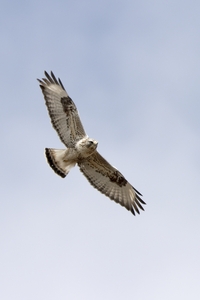
Rough-legged Hawk south of Walden |
Crossing the Continental Divide yet again on CO-125 I stopped at a campsite and found Steller's Jay and more Juncos. Further down the pass there was another Clark's Nutcracker. Where CO-125 met Rt-40 at a lake just above Granby there were both Common Goldeneye and Barrow's Goldeneye.
The pass on Rt-40 was beset by a blizzard that persisted all the way down to I-70, and it was still raining when I passed Georgetown, so I nixed going up Guanella Pass. Instead I went to Loveland Ski Basin, where after a little patience I found 27 Rosy Finches. The light was very high contrast and poor, so I was only sure of the male Gray-crowned Rosy-Finch (#9) although it was possible that one or two of the drabber birds were Brown-capped (however they might also have just been females). The closest report to my sighting listed 30+ Gray-crowned Rosy- Finches so that's a good confirmation. In fact I suspect that most of the Rosy-Finches around where Gray-crowned. 50+ Brown-capped were reported a day or two later (by Eastern birders) but I'm not sure what to make of that report.
I then burnt rubber out of the mountains, down I-25 to Pueblo, US-50 to La Junta and Rt-109 and Rt-106 to Springfield. Persistent heavy drizzle kept me from trying my luck at Western Screech-Owl in Cottonwood Canyon after dark. I stayed in Springfield, a town with few attractions and a lot of trucker traffic... Total 590 miles at the end of an absurd day that saw me cut the diagonal from north-west to south-east Colorado.
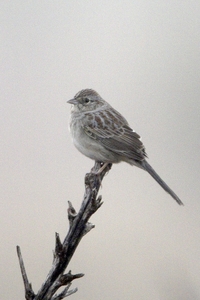 Cassin's Sparrow |
Low visibility due to fog and rain the previous day made driving to the Campo lek on Comanche National Grasslands an "interesting" experience that had me downright scared at times even with 4WD, but nevertheless the directions were good enough to get there. The pawn shop on the NE corner of the turn for Rd J in Campo no longer exists and the empty lot seems to be used by truckers at night. Got to the lek at 5:20am while it was still very dark, but apparently they start lekking even at that hour - I could hear them but not see them. It was some time later that I was actually able to see two male Lesser Prairie-Chickens, although they didn't seem all that fired up. Two people in cars came in after me and left before me. The first (birder) departure may have flushed 1 Prairie-Chicken about 6:30am (dawn was probably 6:40am), the remaining 6 birds apparently left on their own accord a little while later - that was the first indication there were 7 birds there. CDOW turned up a little later to scan the lek but left within 10 minutes (there were no birds). I never saw more than 2 birds at one time, so it's very possible some of the fly-aways were females lurking on the edge of the lek. 20 minutes after fly-out, with no birds seen during that time, I left the lek (7am).
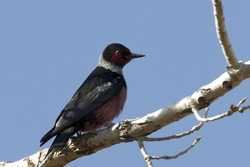
Lewis's Woodpecker |
Cassin's Sparrow were singing at several locations around the lek (as were Western Meadowlark and Horned Lark). Back-tracking to Campo in the morning light I also found: Vesper Sparrow, Killdeer, Long-billed Curlew, White-crowned Sparrow, Rough-legged Hawk. Further west at the picturesque Cottonwood Canyon I found Rufous Crowned Sparrow (singing, difficult to find him), many vocal Lewis's Woodpeckers, several Townsend's Solitaire, Turkey Vulture, Red-tailed Hawk, American Kestrel, two singing Bewick's Wren, heard yet more Canyon Wren, saw two or three flocks of Wild Turkey, Greater Roadrunner, Rock Wren, Eastern Phoebe, Great Blue Heron. A very brief peek into Corrizo Canyon yielded Chihuahuan Raven, Wood Duck, Blue-gray Gnatcatcher, Say's and Eastern Phoebes.
During the interminable drive along Rt-160 to I-25 I also found Swainson's Hawk and Loggerhead Shrike but little else to amuse me. I was taking the long way around to possibly visit Front Range sites on my way up to Pawnee National Grassland. This turned out to be a tactical error, since it took so long to get to I-25, and a more direct route would have been a far smarter idea, perhaps via Bonny State Park.
Two hundred miles (yup, that far) later I pulled into Pawnee National Grasslands amidst low gray clouds and drizzle and proceeded to rummage for Mountain Plover and Longspurs based on various previous directions. I found a few McCown's Longspur along Murphy's Pasture, but nothing much else as dusk approached. No Mountain Plover anywhere despite checking various favorable locations.
My original plan was to drive to Grand Island, Nebraska to a known Greater Prairie-Chicken location, however one look at the map at the Nebraska welcome station had me turn around and stay in Julesburg overnight, just over the border into Colorado and about 70 miles north of Wray, feeling rather defeated. Remarkably there was a WiFi internet connection in the inexpensive motel (via the neighboring Flying J gas station). $3 for 1 hour was a good deal. A sign on the motel wall warned me not to pluck any fowl in the room. This might be construed as a good sign for the availability of Prairie-Chickens, although I wanted to see some live ones. I didn't find any feathers under the bed.
Along Rt-34 west out of Wray on the road to Yuma, I saw a Blue Jay just west of town and a Great-tailed Grackle at the next town on. Returning to Pawnee National Grasslands - I saw Northern Harrier, Swainson's Hawk many McCown's Longspur (in many locations), 3 adult male Chestnut-collared Longspur, but turned up no Mountain Plover despite checking various locations. I also had a Ring-necked Pheasant on Rt-71 just south of grasslands (my only one in Colorado this trip).
Reports of "hundreds" of Rosy Finches up in Estes Park in the Front Range foothills had me heading up there to check them out, but after checking many houses for feeders I found nothing. It was rather amusing that people had herds of Elk feeding on their lawns and around town.
I drove south along the Front Range and on to Steamboat Springs in more or less continual rain. I was planning on rolling the dice at the Sharp-tailed Grouse lek again to see if the rain would abate and if the Grouse would play nice but gave up on that idea since the rain was continual. I stayed at the Rabbit Ears motel in Steamboat Springs (recommended), total 520 miles.
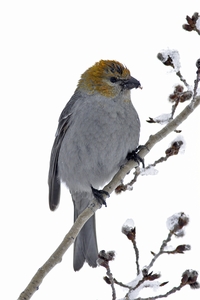
|
Based on an online report, I checked Cattail Pond in Loveland, which held two somewhat wary Trumpeter Swans which made it worth getting wet to 'scope them, with Pied-billed Grebe, Ring-necked Duck, Redhead, Lesser Scaup, and two White Pelican.
Stayed at Motel6 (OK) near Fort Collins at intersection of CO-14/I-25. Total 270 miles. Bad weather all day (either snowing or raining) but still 3 life birds !
I drove up CO-9 through Middle Park, and on Rt-9 south of Kremmeling came across a Ferruginous Hawk flushed from the middle of the road, looking for an instant like a Caracara but giving excellent views as it worked it's way over a neighboring hillside. There was a neighboring Red-tailed Hawk for direct comparison.
I dropped down into North Park via Rt-14 at Muddy Pass on US-40 and again saw Rough-legged Hawk. At the Forest Service Visitor Center on the west side of Cameron Pass there were Gray-crowned Rosy Finch (3), Pine Grosbeak (5+), many "Gray-headed" Dark-eyed Junco, a single "Oregon" Dark-eyed Junco, Black-capped and Mountain Chickadees, Song Sparrow and Red-breasted Nuthatch. I wasn't able to re-find candidate Brown-capped or the two Black Rosy-Finches of the previous afternoon.
Back down the hill near Walden, the Greater Sage Grouse lek at Coalmont was quite snowy but nevertheless I gave it a try at dusk. No grouse but one Prairie Falcon hunting low over the sage.
Overnight: Rabbit Ears Motel (recommended) in Steamboat Springs.
I didn't find any Blue Grouse or Sharp-tailed Grouse leks but there was still some activity at the somewhat distant Greater Sage-Grouse lek with 5 males fitfully displaying. Four of them left the lek after 20 minutes, leaving one male pointlessly displaying into the mid-morning. I edged away from that site with the bird still there.
I backtracked to Steamboat Springs, had breakfast, then left the mountains for the last time. The Loveland Basin ski site was swarming with people (the last skiing day of the season?) but didn't have any feeder birds during my brief visit. I proceeded down I-70 and I-470 and went to Pine Valley Ranch to look for Three-toed Woodpecker. Based on recent sightings of 2 or 3 birds I devised a circular route down three trails (Park View Trail up the hillside, Strawberry Jack and Buck Gulch trail back down it). Despite feeling like I was about to fall over while climbing the Park View trail (still sick, still unfit), I was rewarded by good views at a female American Three-toed Woodpecker chipping bark off a burnt tree about 20 yards west of the trail approximately 20 yards north of the park boundary. 100 yards further on I found Hairy Woodpecker, White-breasted and Red-breasted Nuthatch and Mountain Chickadee. The remainder of the trail did not yield any more Three-toed but was gratifyingly downhill. There were two noisy Northern Flickers and a Belted Kingfisher at the lake. The last "good" bird of the trip was an American Dipper feeding and singing on the fast flowing stream near the parking lot. Since it was getting late and some menacing clouds were on the horizon I simply packed up and headed for Denver rather than pushing my luck looking for Owls after dark.
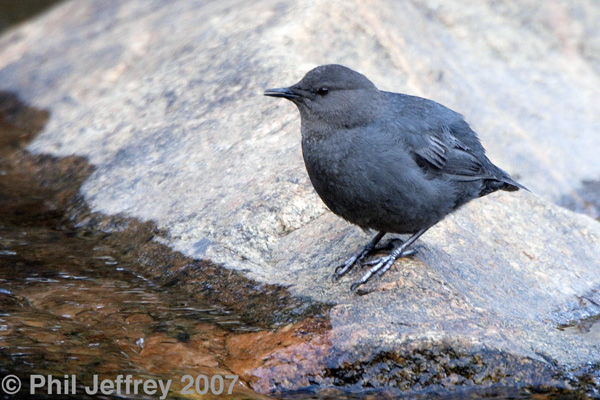 American Dipper at Pine Valley Ranch Park |
Part of the logistical mess on this trip was a mixture of inexperience with the sheer size of Colorado, slowness of the mountain roads, and my traditional screw-up of assuming I can bird five+ sites in one day. I would recommend coming in the second or third week in April rather than the first (I had other constraints) which would give you far better shots at migrant sparrows and warblers while still giving you access to active leks. Stress on the leks is becoming an important issue and all species of Grouse/Prairie-Chickens are on the decline, partially as a result of that. Prospects for both Prairie-Chickens and in particular the Gunnison's Sage Grouse are not good. Currently (2004) there is only one advertized Gunnison lek, the Campo lek for Lesser Prairie-Chicken (now closed?) and the leks around Wray for Greater Prairie-Chicken. There is increased eco-tourism commercialization around Walden (for Greater Sage-Grouse) and Wray (for Gtr Prairie-Chicken) which tend to be a little expensive but at least establish good reasons for preserving at least part of the population. The formerly regular Coalmont Lek near Walden is now no longer publically accessible - as clear an indication as you can imagine as to the population stresses on that environment.